21.11.2025
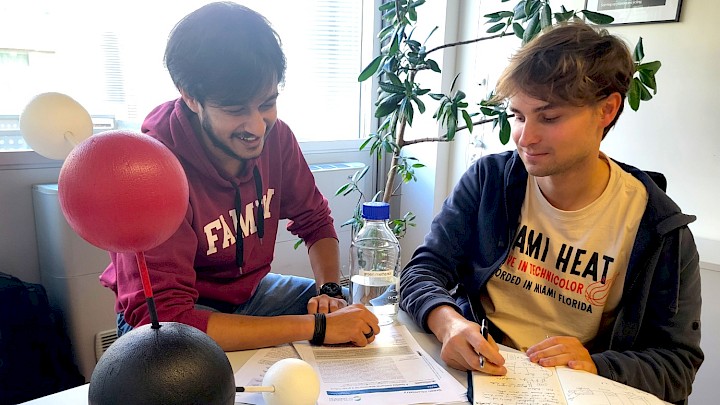
Behind The Publication: A feasible methanol economy for a green future
Abhinandan Nabera and Hidde Kolmeijer discussing the results of the team's methanol economy study.
In a recent publication, NCCR Catalysis researchers highlight methanol’s potential to transform the economy towards a cleaner, more sustainable future. Learn more about the work in this Behind The Publication feature!
What is the methanol economy, and what is the motivation of this work?
The methanol economy, first proposed by Nobel laureate George Olah, envisions using methanol as a clean and versatile alternative to fossil feedstocks such as gasoline, natural gas, and naphtha, which are used today to produce fuels and chemicals. Methanol can not only power vehicles, ships, and planes, but also serve as a key building block for producing a wide range of chemicals. Crucially, it can be synthesized from renewable sources such as biomass, biogas, or even captured CO2 from the air. This NCCR Catalysis study expands on Olah’s vision by providing the first quantitative assessment of a methanol‑based economy by 2050, identifying the most effective pathways to realize it. The goal is to clarify the true environmental and economic potential of methanol as a foundation for a sustainable society.
Overview of the proposed methanol economy. Methanol produced from fossil or renewable sources can be used across several sectors. It serves as a chemical feedstock and as a fuel for road transport and shipping, and can also be converted into jet fuel through the methanol-to-kerosene process for use in aviation.
Which was the main challenge? How did you address it?
The main challenge was to move beyond the community’s qualitative optimism about the methanol economy and develop a rigorous, quantitative assessment under realistic future conditions spanning entire sectors of the economy, such as fuels for transport and chemicals. Achieving this required several years of work, as we integrated previously developed partial models into a comprehensive 2050 framework that links methanol production and use pathways with prospective life-cycle assessment and techno‑economic analyses. This allowed us to evaluate numerous configurations, consider different renewable carbon sources, account for the limited availability of bio‑based feedstocks, and compare all options on a consistent basis.
What are the study’s main results and take-home messages?
The formal aspects of the analysis may be complex, but the results are clear. A methanol economy could significantly cut global greenhouse gas emissions while remaining broadly affordable by 2050. Specifically, producing methanol from biomass and biogas can reach net‑zero or even negative emissions, though these resources alone are insufficient to meet the projected methanol demand. By combining these bio‑based routes with CO2 hydrogenation technologies, a fully renewable pathway emerges; one capable of net‑zero emissions at an estimated cost of about US$ 32 per person per month. This is comparable to other 2°C scenarios under the Paris Agreement, or, put more simply, to the price of a subscription to a good-quality streaming service. We could also identify the order in which implementation would be more beneficial: rapid adoption in road transport and chemicals, followed by aviation and shipping. One key takeaway is the importance of continued investment in CO2 hydrogenation technologies to ensure they reach commercial maturity.
Key findings of the evaluated methanol economy scenarios. The analysis identifies two viable pathways, both reliant on biomass and biogas feedstocks due to their comparatively low costs and substantial CO2 emission reductions. In the bio + CO2 scenario, the methanol economy achieves net-zero emissions at an estimated cost of US$ 32 per capita per month. Alternatively, a fossil-based pathway remains feasible at approximately half the cost, albeit with higher residual emissions.
What makes this work particularly relevant for NCCR Catalysis and the research community?
The study demonstrates that CO2 hydrogenation to methanol is essential to overcoming the limited supply of sustainable biomass and biogas, enabling a fully renewable methanol economy with net‑zero greenhouse gas emissions. This directly aligns with the NCCR Catalysis vision of sustainable, carbon‑neutral value chains, in which the development of advanced catalytic systems for CO2 conversion is a central pillar. Our findings also show that the methanol economy is a practical pathway to meet global climate commitments. We hope these results will energize the scientific community and encourage dialogue among researchers, industrialists, and policymakers toward their real-world implementation.
Publication details:
A feasible methanol economy for a green future. H. Kolmeijer, A. Nabera, A.J. Martín, G. Guillén-Gosálbez, J. Pérez-Ramírez. Green Chem. 2025. DOI: 10.1039/d5gc04615g.
In a recent publication, NCCR Catalysis researchers highlight methanol’s potential to transform the economy towards a cleaner, more sustainable future. Learn more about the work in this Behind The Publication feature!
What is the methanol economy, and what is the motivation of this work?
The methanol economy, first proposed by Nobel laureate George Olah, envisions using methanol as a clean and versatile alternative to fossil feedstocks such as gasoline, natural gas, and naphtha, which are used today to produce fuels and chemicals. Methanol can not only power vehicles, ships, and planes, but also serve as a key building block for producing a wide range of chemicals. Crucially, it can be synthesized from renewable sources such as biomass, biogas, or even captured CO2 from the air. This NCCR Catalysis study expands on Olah’s vision by providing the first quantitative assessment of a methanol‑based economy by 2050, identifying the most effective pathways to realize it. The goal is to clarify the true environmental and economic potential of methanol as a foundation for a sustainable society.
Overview of the proposed methanol economy. Methanol produced from fossil or renewable sources can be used across several sectors. It serves as a chemical feedstock and as a fuel for road transport and shipping, and can also be converted into jet fuel through the methanol-to-kerosene process for use in aviation.
Which was the main challenge? How did you address it?
The main challenge was to move beyond the community’s qualitative optimism about the methanol economy and develop a rigorous, quantitative assessment under realistic future conditions spanning entire sectors of the economy, such as fuels for transport and chemicals. Achieving this required several years of work, as we integrated previously developed partial models into a comprehensive 2050 framework that links methanol production and use pathways with prospective life-cycle assessment and techno‑economic analyses. This allowed us to evaluate numerous configurations, consider different renewable carbon sources, account for the limited availability of bio‑based feedstocks, and compare all options on a consistent basis.
What are the study’s main results and take-home messages?
The formal aspects of the analysis may be complex, but the results are clear. A methanol economy could significantly cut global greenhouse gas emissions while remaining broadly affordable by 2050. Specifically, producing methanol from biomass and biogas can reach net‑zero or even negative emissions, though these resources alone are insufficient to meet the projected methanol demand. By combining these bio‑based routes with CO2 hydrogenation technologies, a fully renewable pathway emerges; one capable of net‑zero emissions at an estimated cost of about US$ 32 per person per month. This is comparable to other 2°C scenarios under the Paris Agreement, or, put more simply, to the price of a subscription to a good-quality streaming service. We could also identify the order in which implementation would be more beneficial: rapid adoption in road transport and chemicals, followed by aviation and shipping. One key takeaway is the importance of continued investment in CO2 hydrogenation technologies to ensure they reach commercial maturity.
Key findings of the evaluated methanol economy scenarios. The analysis identifies two viable pathways, both reliant on biomass and biogas feedstocks due to their comparatively low costs and substantial CO2 emission reductions. In the bio + CO2 scenario, the methanol economy achieves net-zero emissions at an estimated cost of US$ 32 per capita per month. Alternatively, a fossil-based pathway remains feasible at approximately half the cost, albeit with higher residual emissions.
What makes this work particularly relevant for NCCR Catalysis and the research community?
The study demonstrates that CO2 hydrogenation to methanol is essential to overcoming the limited supply of sustainable biomass and biogas, enabling a fully renewable methanol economy with net‑zero greenhouse gas emissions. This directly aligns with the NCCR Catalysis vision of sustainable, carbon‑neutral value chains, in which the development of advanced catalytic systems for CO2 conversion is a central pillar. Our findings also show that the methanol economy is a practical pathway to meet global climate commitments. We hope these results will energize the scientific community and encourage dialogue among researchers, industrialists, and policymakers toward their real-world implementation.
Publication details:
A feasible methanol economy for a green future. H. Kolmeijer, A. Nabera, A.J. Martín, G. Guillén-Gosálbez, J. Pérez-Ramírez. Green Chem. 2025. DOI: 10.1039/d5gc04615g.
1.7.2025
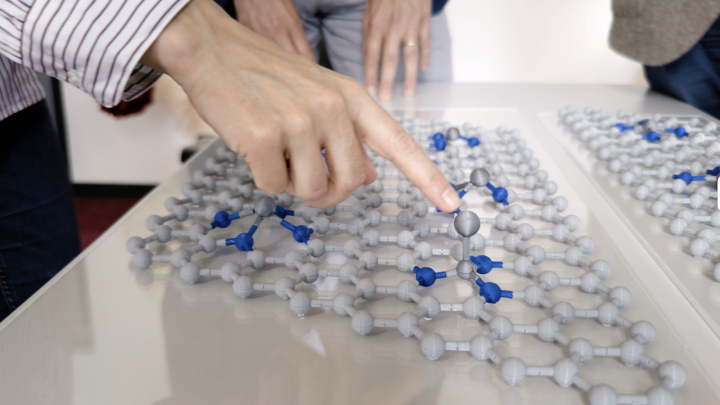
New study reveals hidden diversity in single-atom catalysts
An international collaboration led by NCCR Catalysis groups has demonstrated, for the first time, that not all single atoms in single-atom catalysts are alike. Researchers from ETH Zurich, CRMN Lyon, and Aarhus University applied solid-state platinum NMR spectroscopy to distinguish the distinct local environments of platinum atoms dispersed on various supports.
The study reveals that materials that appear identical by transmission electron microscopy can exhibit a range of coordination environments at the atomic level, with direct implications for their catalytic performance. The researchers further demonstrated how different synthesis protocols and supports influence the nature and evolution of active sites during catalyst evaluation, offering new insights into catalyst stability.
This advance was made possible through close collaboration across institutions and disciplines, combining synthesis, advanced spectroscopy, and theory. The findings mark a major step toward atomic-scale understanding and precision design in heterogeneous catalysis.
In the video, NCCR Catalysis members, including Prof. Javier Pérez-Ramírez, Prof. Christophe Copéret, Dr. Sharon Mitchell, Dr. Alexander Yakimov, Marc-Eduard Usteri (ETH Zurich), and Dr. Jonas Koppe (CRMN Lyon), share their perspectives on this exciting breakthrough in the description of single-atom catalysts.
The study reveals that materials that appear identical by transmission electron microscopy can exhibit a range of coordination environments at the atomic level, with direct implications for their catalytic performance. The researchers further demonstrated how different synthesis protocols and supports influence the nature and evolution of active sites during catalyst evaluation, offering new insights into catalyst stability.
This advance was made possible through close collaboration across institutions and disciplines, combining synthesis, advanced spectroscopy, and theory. The findings mark a major step toward atomic-scale understanding and precision design in heterogeneous catalysis.
In the video, NCCR Catalysis members, including Prof. Javier Pérez-Ramírez, Prof. Christophe Copéret, Dr. Sharon Mitchell, Dr. Alexander Yakimov, Marc-Eduard Usteri (ETH Zurich), and Dr. Jonas Koppe (CRMN Lyon), share their perspectives on this exciting breakthrough in the description of single-atom catalysts.
22.1.2025

2025 IUPAC-Zhejiang NHU International Award for Prof. Javier Pérez-Ramírez
The IUPAC-Zhejiang NHU International Award for Advancements in Green Chemistry, presented biannually at the IUPAC World Chemistry Congress (WCC), honors one established and three early-career scientists in the chemical sciences for their efforts in advancing green chemistry. Prof. Pérez-Ramírez’s recognition centers on his groundbreaking contributions to transforming the landscape of sustainable chemical and energy production. His achievements include the design of a novel catalyst for green methanol synthesis now piloted in industry, the introduction of novel catalysts for CO2 conversion to long-chain hydrocarbons, and pioneering concepts for decentralized ammonia production.
Many of these breakthroughs were achieved within the collaborative framework of NCCR Catalysis, which has also advanced the adoption of digital tools to accelerate catalyst discovery. By integrating sustainability metrics and life-cycle assessments into chemical process design, his work exemplifies the perfect synergy between cutting-edge innovation and environmental responsibility. Congratulations on this well-deserved recognition of your innovative and sustainability-guided contributions to the field, Javier!
Javier will receive the award and deliver a lecture at the 50WCC in Kuala Lumpur, Malaysia, in July 2025.
Many of these breakthroughs were achieved within the collaborative framework of NCCR Catalysis, which has also advanced the adoption of digital tools to accelerate catalyst discovery. By integrating sustainability metrics and life-cycle assessments into chemical process design, his work exemplifies the perfect synergy between cutting-edge innovation and environmental responsibility. Congratulations on this well-deserved recognition of your innovative and sustainability-guided contributions to the field, Javier!
Javier will receive the award and deliver a lecture at the 50WCC in Kuala Lumpur, Malaysia, in July 2025.
1.10.2024

Behind The Publication: Assessing transport phenomena in chemical plastic recycling
Shibashish Jaydev after successfully defending his PhD work at ETH Hönggerberg in September 2024.
In a recent publication, NCCR Catalysis researchers and colleagues highlight the importance of transport phenomena in chemical recycling of polyolefins and derive a metric for catalyst performance evaluation. Learn more about the work from Shibashish Jaydev in this Behind The Publication feature!
Could you tell us about yourself and the way toward this project?
I started at ETH Zurich as a Master’s student in 2018 and then decided to stay for a PhD. I had the pleasure of working on a variety of scientific topics, such as multiphase flows, microfabrication, cytometry and image processing. The common aspect of my student career was that I always wanted to try something new.
At some point, I felt I should come back to my core competence in chemical reaction engineering and approached Prof. Javier Pérez-Ramírez for a PhD position on the topic of chemical recycling of plastics. We decided to tackle polyolefins (polyethylene and polypropylene, comprising around 60% of all plastic waste), using an emerging route called hydrogenolysis, where hydrogen is also a reactant. After initially working on nanoscale catalyst design, we decided to shift our focus to the reactor scale due to the practical nature of the chemical recycling problem. With increasing scale, we realized that the reaction was heat and mass transfer limited, thereby hindering us from realizing the full potential of our catalysts. This led to the conception of this project to assess the influence of transport processes on catalyst effectiveness, which we could pursue thanks to an ETH Grant.
Prof. Javier Pérez-Ramírez, Shibashish Jaydev and Dr. Antonio José Martín Fernández from the aCe group at ETH Hönggerberg in September 2024.
What are the motivation and main results of this project?
In spite of designing and evaluating catalysts that showed great promise, we were convinced to be limited by factors at the reactor scale. The batch reaction we investigated involves three distinct phases, and can only take place when the hydrogen, the catalyst particles and the plastic molecules come together. This means the reaction had to be limited by transport processes, particularly mass transfer, owing to the high viscosity of the plastic melt. An easy way to show this was the changing catalytic performance with the stirring rate. As every research group working in this field uses a different setup, a different stirrer, there was no real way of assessing the extent to which external factors impacted the intrinsic catalyst performance. In this work, we present a means by which this can be done rather easily, independent of the setup or the catalysts.
Which was the main challenge? How did you address it?
Transport processes within a batch reactor system in plastic recycling could be influenced by a multitude of factors - viscosity, stirring speed, vessel dimensions, density and the extent of interfacial contact between the phases. The biggest challenge was to combine these factors into a single equation and present it in an accessible manner for other researchers. We addressed this by looking into possible dimensionless numbers that could help us account for all the factors at once. We thus arrived at a reinterpretation of the well-known power number, something other practitioners could also employ in their own research.
Shibashish Jaydev next to the parallel pressure reactor setup used in the study.
What impact did the ETH Grant have on this work?
As the ETH grant is awarded to high-risk, high-reward projects, the chemical recycling project was a perfect candidate. It provided us with the financial freedom to take risks in terms of exploring and pursuing radically innovative ideas in the initial phases of the project. We were able to expand the scope of our research in catalyst design and explore this reaction thanks to the support provided by the ETH grant.The solid foundation we could lay down owing to the ETH grant culminated in this project which, as a precursor, required access to superior catalysts, a sophisticated setup and other state-of-the-art technologies made possible through the grant.
What is your view on the integration of chemical recycling of plastics in Phase II of NCCR Catalysis?
The project, after its successful run so far, is now at a juncture where it requires multi-domain expertise and collaboration. It has now matured enough to need the involvement of more than one research group - material scientists to study rheology, chemists for operando studies, process and systems engineers for techno-economic studies and also social scientists for macro-level study of the plastic waste problem. I believe NCCR Catalysis offers this collaborative platform to exchange ideas and effectively tackle this multifaceted challenge. Besides, the platform also offers greater visibility to this research topic, inviting broader interests.
Polyolefins - among them polypropylene, which can be made into bottle caps - account for 60% of all plastic waste. © Shibashish Jaydev
What are your future, post-graduation plans?
Right after my PhD, I will start as an R&D Engineer in the chemical process development industry. Since my core interest lies in chemical engineering, I wish to continue working on the design of processes and reactors. I will, however, look to expand my knowledge in the direction of life cycle assessments and economic aspects of chemical processes. A long-term priority for me would be to maintain a solid work-life balance with a lot of sports and spending more time in the mountains.
Publication details:
Assessment of transport phenomena in catalyst effectiveness for chemical polyolefin recycling. S.D. Jaydev, A.J. Martín, D. Garcia, K. Chikri, J. Pérez-Ramírez. Nat. Chem. Eng. 2024, 1, 565. DOI: 10.1038/s44286-024-00108-3.
In a recent publication, NCCR Catalysis researchers and colleagues highlight the importance of transport phenomena in chemical recycling of polyolefins and derive a metric for catalyst performance evaluation. Learn more about the work from Shibashish Jaydev in this Behind The Publication feature!
Could you tell us about yourself and the way toward this project?
I started at ETH Zurich as a Master’s student in 2018 and then decided to stay for a PhD. I had the pleasure of working on a variety of scientific topics, such as multiphase flows, microfabrication, cytometry and image processing. The common aspect of my student career was that I always wanted to try something new.
At some point, I felt I should come back to my core competence in chemical reaction engineering and approached Prof. Javier Pérez-Ramírez for a PhD position on the topic of chemical recycling of plastics. We decided to tackle polyolefins (polyethylene and polypropylene, comprising around 60% of all plastic waste), using an emerging route called hydrogenolysis, where hydrogen is also a reactant. After initially working on nanoscale catalyst design, we decided to shift our focus to the reactor scale due to the practical nature of the chemical recycling problem. With increasing scale, we realized that the reaction was heat and mass transfer limited, thereby hindering us from realizing the full potential of our catalysts. This led to the conception of this project to assess the influence of transport processes on catalyst effectiveness, which we could pursue thanks to an ETH Grant.
Prof. Javier Pérez-Ramírez, Shibashish Jaydev and Dr. Antonio José Martín Fernández from the aCe group at ETH Hönggerberg in September 2024.
What are the motivation and main results of this project?
In spite of designing and evaluating catalysts that showed great promise, we were convinced to be limited by factors at the reactor scale. The batch reaction we investigated involves three distinct phases, and can only take place when the hydrogen, the catalyst particles and the plastic molecules come together. This means the reaction had to be limited by transport processes, particularly mass transfer, owing to the high viscosity of the plastic melt. An easy way to show this was the changing catalytic performance with the stirring rate. As every research group working in this field uses a different setup, a different stirrer, there was no real way of assessing the extent to which external factors impacted the intrinsic catalyst performance. In this work, we present a means by which this can be done rather easily, independent of the setup or the catalysts.
Which was the main challenge? How did you address it?
Transport processes within a batch reactor system in plastic recycling could be influenced by a multitude of factors - viscosity, stirring speed, vessel dimensions, density and the extent of interfacial contact between the phases. The biggest challenge was to combine these factors into a single equation and present it in an accessible manner for other researchers. We addressed this by looking into possible dimensionless numbers that could help us account for all the factors at once. We thus arrived at a reinterpretation of the well-known power number, something other practitioners could also employ in their own research.
Shibashish Jaydev next to the parallel pressure reactor setup used in the study.
What impact did the ETH Grant have on this work?
As the ETH grant is awarded to high-risk, high-reward projects, the chemical recycling project was a perfect candidate. It provided us with the financial freedom to take risks in terms of exploring and pursuing radically innovative ideas in the initial phases of the project. We were able to expand the scope of our research in catalyst design and explore this reaction thanks to the support provided by the ETH grant.The solid foundation we could lay down owing to the ETH grant culminated in this project which, as a precursor, required access to superior catalysts, a sophisticated setup and other state-of-the-art technologies made possible through the grant.
What is your view on the integration of chemical recycling of plastics in Phase II of NCCR Catalysis?
The project, after its successful run so far, is now at a juncture where it requires multi-domain expertise and collaboration. It has now matured enough to need the involvement of more than one research group - material scientists to study rheology, chemists for operando studies, process and systems engineers for techno-economic studies and also social scientists for macro-level study of the plastic waste problem. I believe NCCR Catalysis offers this collaborative platform to exchange ideas and effectively tackle this multifaceted challenge. Besides, the platform also offers greater visibility to this research topic, inviting broader interests.
Polyolefins - among them polypropylene, which can be made into bottle caps - account for 60% of all plastic waste. © Shibashish Jaydev
What are your future, post-graduation plans?
Right after my PhD, I will start as an R&D Engineer in the chemical process development industry. Since my core interest lies in chemical engineering, I wish to continue working on the design of processes and reactors. I will, however, look to expand my knowledge in the direction of life cycle assessments and economic aspects of chemical processes. A long-term priority for me would be to maintain a solid work-life balance with a lot of sports and spending more time in the mountains.
Publication details:
Assessment of transport phenomena in catalyst effectiveness for chemical polyolefin recycling. S.D. Jaydev, A.J. Martín, D. Garcia, K. Chikri, J. Pérez-Ramírez. Nat. Chem. Eng. 2024, 1, 565. DOI: 10.1038/s44286-024-00108-3.
11.9.2024

Official launch of Phase II
On 11 September 2024, we officially launched our program's second funding phase (2024-2028) at Welle7 in Bern with our PIs and group delegates! The meeting served to initiate discussions on our grand research and structure-related challenges and to strengthen collaborations.
We started with input on and insights into program operations and gender balance, plans for higher educational programs, and our network-wide data strategy.
We then enjoyed interactive sessions prepared by our WP Coordinators and colleagues on the standardization of methodologies, strategies for bridging activities in renewable platforms and complex molecules, long-term stability challenges and opportunities in catalysis, and ways to leverage data within our program. We wrapped the meeting up with perspectives on the definition and integration of sustainability and plans for strategic partnerships and the upcoming months.
We started with input on and insights into program operations and gender balance, plans for higher educational programs, and our network-wide data strategy.
We then enjoyed interactive sessions prepared by our WP Coordinators and colleagues on the standardization of methodologies, strategies for bridging activities in renewable platforms and complex molecules, long-term stability challenges and opportunities in catalysis, and ways to leverage data within our program. We wrapped the meeting up with perspectives on the definition and integration of sustainability and plans for strategic partnerships and the upcoming months.
3.9.2024

Strengthening Swiss-Singaporean exchanges on sustainable chemistry research
Group photo of the ETH Zurich-NUS CHI meeting participants taken at NUS on 3 September 2024.
In a recent visit to the National University of Singapore (NUS), delegates from ETH Zurich met with members of the Centre for Hydrogen Innovations (CHI) for a symposium on Replacing Fuels by Chemistry. The symposium was held to strengthen Swiss-Singaporean exchanges in this area, in particular between NCCR Catalysis and NUS-CHI.
Panel discussion at the NUS CHI-ETH Zurich symposium with ETH Zurich professors Victor Mougel, Christophe Copéret, Javier Pérez-Ramírez, Gonzalo Guillén-Gosálbez and Christoph Müller.
The ETH Zurich delegation included NCCR Catalysis members Prof. Javier Pérez-Ramírez (Program Director), Dr. Sharon Mitchell (Program Advisor), Prof. Christophe Copéret (co-coordinator of WP3 Advanced tools), Prof. Gonzalo Guillén-Gosálbez (co-coordinator of WP5 Sustainability), and Prof. Christoph Müller (Principal Investigator), and Prof. Victor Mougel.
Prof. Javier Pérez-Ramírez with NUS hosts professors Dan Zhao (CHI), Ning Yan (CHI Program Director) and Jason Yeo.
As Program Directors of CHI and NCCR Catalysis, respectively, Prof. Ning Yan and Prof. Javier Peréz-Ramírez gave welcoming addresses to kick off the meeting.
The ETH Zurich delegation contributed talks on:
Prof. Javier Pérez-Ramírez: Catalysis and Sustainability: A Journey from Atom to Planet
Prof. Christophe Copéret: Preparation and Characterisation of Heterogeneous Catalysts, One Atom at a Time
Prof. Gonzalo Guillén-Gosálbez: Sustainability Metrics for Chemicals Within Planetary Boundaries
Prof. Christoph Müller: CO2 Capture and Thermocatalytic CO2 Conversion: Model Materials and Their Characterisation
Prof. Victor Mougel: Bio-Inspired Strategies for the Design of Electrocatalysts for Small Molecule Activation
They also contributed to a panel discussion on the role of science, education and policy in decarbonizing the chemical industry.
In addition to the symposium, the visit also included sightseeing and meeting with NUS students, and exchanges with the Singapore-ETH Centre. We thank the delegation’s hosts for their warm welcome and look forward to further fruitful exchanges!
Members of the ETH Zurich delegation with their hosts, visiting the Gardens by the Bay with NUS students and the National Orchid Garden Singapore Botanic Gardens.
In a recent visit to the National University of Singapore (NUS), delegates from ETH Zurich met with members of the Centre for Hydrogen Innovations (CHI) for a symposium on Replacing Fuels by Chemistry. The symposium was held to strengthen Swiss-Singaporean exchanges in this area, in particular between NCCR Catalysis and NUS-CHI.
Panel discussion at the NUS CHI-ETH Zurich symposium with ETH Zurich professors Victor Mougel, Christophe Copéret, Javier Pérez-Ramírez, Gonzalo Guillén-Gosálbez and Christoph Müller.
The ETH Zurich delegation included NCCR Catalysis members Prof. Javier Pérez-Ramírez (Program Director), Dr. Sharon Mitchell (Program Advisor), Prof. Christophe Copéret (co-coordinator of WP3 Advanced tools), Prof. Gonzalo Guillén-Gosálbez (co-coordinator of WP5 Sustainability), and Prof. Christoph Müller (Principal Investigator), and Prof. Victor Mougel.
Prof. Javier Pérez-Ramírez with NUS hosts professors Dan Zhao (CHI), Ning Yan (CHI Program Director) and Jason Yeo.
As Program Directors of CHI and NCCR Catalysis, respectively, Prof. Ning Yan and Prof. Javier Peréz-Ramírez gave welcoming addresses to kick off the meeting.
The ETH Zurich delegation contributed talks on:
Prof. Javier Pérez-Ramírez: Catalysis and Sustainability: A Journey from Atom to Planet
Prof. Christophe Copéret: Preparation and Characterisation of Heterogeneous Catalysts, One Atom at a Time
Prof. Gonzalo Guillén-Gosálbez: Sustainability Metrics for Chemicals Within Planetary Boundaries
Prof. Christoph Müller: CO2 Capture and Thermocatalytic CO2 Conversion: Model Materials and Their Characterisation
Prof. Victor Mougel: Bio-Inspired Strategies for the Design of Electrocatalysts for Small Molecule Activation
They also contributed to a panel discussion on the role of science, education and policy in decarbonizing the chemical industry.
In addition to the symposium, the visit also included sightseeing and meeting with NUS students, and exchanges with the Singapore-ETH Centre. We thank the delegation’s hosts for their warm welcome and look forward to further fruitful exchanges!
Members of the ETH Zurich delegation with their hosts, visiting the Gardens by the Bay with NUS students and the National Orchid Garden Singapore Botanic Gardens.
27.6.2024
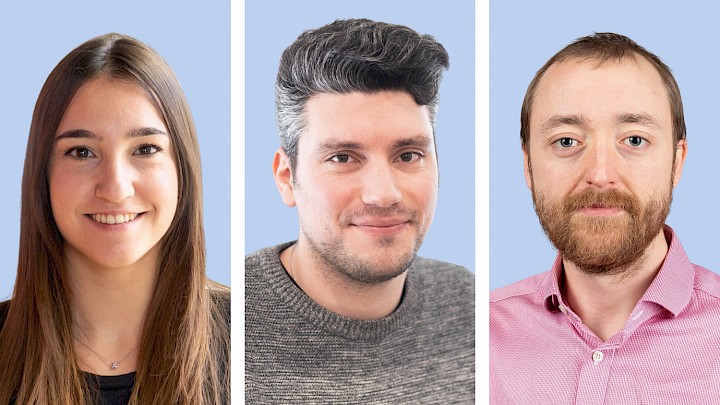
From Spain to Switzerland: a lab exchange between computational and experimental researchers
Team portrait, from left to right: Andrea Ruiz-Ferrando, Dr. Javier Heras-Domingo, and Dr. Adam Clark.In March, two researchers from ICIQ in Spain came to PSI and ETH Zurich, Switzerland for a one-week lab exchange supported through the NCCR Catalysis Catalyzer Program. Meet Andrea Ruiz-Ferrando and Dr. Javier Heras-Domingo, who share their impressions from their exchange hosted by Dr. Adam Clark, and their experiences on bridging the gap between experimental and computational groups!
Hi Andrea and Javi, could you tell us about yourselves and your research within NCCR Catalysis?Andrea: I hold a degree in chemistry and have been a PhD student in the group of Prof. Núria López at ICIQ since 2020. My research is centered on the fascinating realm of single-atom catalysts within the domain of theoretical chemistry. Specifically, I delve into finding experimentally guided synthesis-structure-property relationships inherent to these catalytic systems. What makes my work particularly exciting is the interdisciplinary nature of my approach: I collaborate with experimentalists, bridging the gap between theory and practice. I enjoy engaging in social activities, whether it’s exploring new places or meeting new people, and the lab exchange was a great opportunity for this.Javi: Originally from Barcelona, I completed my PhD in Computational Chemistry at the Universitat Autònoma de Barcelona. My academic journey then took me to the United States, where I spent three enriching years at Carnegie Mellon University for my first postdoctoral researcher position. During this time, I collaborated with Facebook AI to dive into data science and deep learning approaches applied to chemistry and, in particular, to heterogeneous catalysis. Nowadays, I’m a postdoctoral researcher in Prof. Núria López’s research group, focusing on pushing the boundaries of characterization techniques leveraging the power of artificial intelligence (AI), with the aim to extract more quantitative data that will help to design better catalysts with tailored properties.Javi, Andrea and Adam in front of PSI’s Swiss Light Source facilities (left), and Javi and Adam discussing their project (right).How did the collaboration between the López, Pérez-Ramírez groups and Dr. Adam Clark emerge, and what insights have you gained from this collaboration?Javi: The smart characterization research line originated from a collaborative effort between Prof. Núria López’s group at ICIQ, Prof. Javier Pérez-Ramírez at ETH Zurich, and the Barcelona Supercomputing Center (BSC), implementing a deep learning model to detect single-atom catalysts via electron microscopy back in the pandemic. Our current project, a collaboration between ICIQ, ETH, and PSI, aims to enhance catalyst design through advanced characterization strategies, leveraging automated data generation and AI in synchrotron-based techniques like XANES (X-ray Absorption Near Edge Structure) and EXAFS (Extended X-ray Absorption Fine Structure). This approach promises advancements in catalysis, with far-reaching socio-economic impacts.You recently did a one-week lab exchange at PSI and ETH Zurich, Switzerland. How has this exchange benefited you as researchers and the project?Javi: The Catalyzer Program we recently participated in has proven to be an invaluable asset for advancing our current research project. During an intensive one-week laboratory exchange, we gained profound insights into the intricacies of extracting data from EXAFS spectra. This hands-on experience has significantly enriched our understanding, placing us in a much stronger position to incorporate AI into enhancing this technique. The knowledge and techniques acquired through this program have not only bolstered our research capabilities but also opened new avenues for innovation in applying AI to improve data analysis and extraction methods in our field.Andrea, Adam, and Javi having dinner with Dr. Olga Safonova, NCCR Catalysis Principal Investigator at PSI (left), and Javi and Andrea meeting with Vera Giulimondi and Dr. Sharon Mitchell from the group of NCCR Catalysis Director Prof. Javier Pérez-Ramírez at ETH Zurich (right).What advice would you give other early-career researchers on collaborations and exchanges between labs?Andrea: Forge fruitful collaborations by actively seeking shared interests and laying the foundation with ontologies - the common language that ensures effective communication. Embrace diverse perspectives to collaboratively define the project's scope and determine the correct methodology for seamless progress. Be adaptable to changes and uncertainties, cultivating a collaborative mindset that views differences as opportunities for collective growth. Ensure the adoption of an integrative approach right from the outset, emphasizing a cooperative evolution of the project. This proactive stand prevents potential misconceptions and exploits synergistic relationships across research groups.What will be the next steps in your collaboration?Andrea & Javi: The next phase of our collaboration is set to significantly enhance our AI method by integrating experimental data. This pivotal step will not only broaden the method’s applicability but also ensure its robustness in predicting outcomes in experimental environments. Such a move is essential, as relying solely on theoretical data limits our understanding and the potential for real-world applications. Incorporating experimental insights will equip our AI approach with a much-needed depth, making it a more general and powerful tool for navigating the complexities of experimental conditions.Thank you so much for sharing your experience! We wish you and your colleagues the very best for your project.
Learn more about Andrea’s research here and here, and connect with her on Twitter/X and LinkedIn. Learn more about Javier’s research here and here, and connect with him on Twitter/X and LinkedIn.
Hi Andrea and Javi, could you tell us about yourselves and your research within NCCR Catalysis?Andrea: I hold a degree in chemistry and have been a PhD student in the group of Prof. Núria López at ICIQ since 2020. My research is centered on the fascinating realm of single-atom catalysts within the domain of theoretical chemistry. Specifically, I delve into finding experimentally guided synthesis-structure-property relationships inherent to these catalytic systems. What makes my work particularly exciting is the interdisciplinary nature of my approach: I collaborate with experimentalists, bridging the gap between theory and practice. I enjoy engaging in social activities, whether it’s exploring new places or meeting new people, and the lab exchange was a great opportunity for this.Javi: Originally from Barcelona, I completed my PhD in Computational Chemistry at the Universitat Autònoma de Barcelona. My academic journey then took me to the United States, where I spent three enriching years at Carnegie Mellon University for my first postdoctoral researcher position. During this time, I collaborated with Facebook AI to dive into data science and deep learning approaches applied to chemistry and, in particular, to heterogeneous catalysis. Nowadays, I’m a postdoctoral researcher in Prof. Núria López’s research group, focusing on pushing the boundaries of characterization techniques leveraging the power of artificial intelligence (AI), with the aim to extract more quantitative data that will help to design better catalysts with tailored properties.Javi, Andrea and Adam in front of PSI’s Swiss Light Source facilities (left), and Javi and Adam discussing their project (right).How did the collaboration between the López, Pérez-Ramírez groups and Dr. Adam Clark emerge, and what insights have you gained from this collaboration?Javi: The smart characterization research line originated from a collaborative effort between Prof. Núria López’s group at ICIQ, Prof. Javier Pérez-Ramírez at ETH Zurich, and the Barcelona Supercomputing Center (BSC), implementing a deep learning model to detect single-atom catalysts via electron microscopy back in the pandemic. Our current project, a collaboration between ICIQ, ETH, and PSI, aims to enhance catalyst design through advanced characterization strategies, leveraging automated data generation and AI in synchrotron-based techniques like XANES (X-ray Absorption Near Edge Structure) and EXAFS (Extended X-ray Absorption Fine Structure). This approach promises advancements in catalysis, with far-reaching socio-economic impacts.You recently did a one-week lab exchange at PSI and ETH Zurich, Switzerland. How has this exchange benefited you as researchers and the project?Javi: The Catalyzer Program we recently participated in has proven to be an invaluable asset for advancing our current research project. During an intensive one-week laboratory exchange, we gained profound insights into the intricacies of extracting data from EXAFS spectra. This hands-on experience has significantly enriched our understanding, placing us in a much stronger position to incorporate AI into enhancing this technique. The knowledge and techniques acquired through this program have not only bolstered our research capabilities but also opened new avenues for innovation in applying AI to improve data analysis and extraction methods in our field.Andrea, Adam, and Javi having dinner with Dr. Olga Safonova, NCCR Catalysis Principal Investigator at PSI (left), and Javi and Andrea meeting with Vera Giulimondi and Dr. Sharon Mitchell from the group of NCCR Catalysis Director Prof. Javier Pérez-Ramírez at ETH Zurich (right).What advice would you give other early-career researchers on collaborations and exchanges between labs?Andrea: Forge fruitful collaborations by actively seeking shared interests and laying the foundation with ontologies - the common language that ensures effective communication. Embrace diverse perspectives to collaboratively define the project's scope and determine the correct methodology for seamless progress. Be adaptable to changes and uncertainties, cultivating a collaborative mindset that views differences as opportunities for collective growth. Ensure the adoption of an integrative approach right from the outset, emphasizing a cooperative evolution of the project. This proactive stand prevents potential misconceptions and exploits synergistic relationships across research groups.What will be the next steps in your collaboration?Andrea & Javi: The next phase of our collaboration is set to significantly enhance our AI method by integrating experimental data. This pivotal step will not only broaden the method’s applicability but also ensure its robustness in predicting outcomes in experimental environments. Such a move is essential, as relying solely on theoretical data limits our understanding and the potential for real-world applications. Incorporating experimental insights will equip our AI approach with a much-needed depth, making it a more general and powerful tool for navigating the complexities of experimental conditions.Thank you so much for sharing your experience! We wish you and your colleagues the very best for your project.
Learn more about Andrea’s research here and here, and connect with her on Twitter/X and LinkedIn. Learn more about Javier’s research here and here, and connect with him on Twitter/X and LinkedIn.
30.4.2024

Behind The Publication: Exploring Cu-promoted ZnZrOx catalysts for CO2 to methanol synthesis
Team portrait, from left to right: Dr. Thaylan Pinheiro Araújo, Dr. Jordi Morales Vidal, Dr. Mikhail Agrachev, and Patrik Willi.
In a recent collaborative publication, a team of experimental and computational experts from four NCCR Catalysis member groups investigated a sustainable class of catalyst promoters and their workings. Learn more about the work from Dr. Thaylan Pinheiro Araújo (aCe lab, ETHZ), Dr. Jordi Morales Vidal (TheorHetCat Group, ICIQ), Dr. Mikhail Agrachev (EPR Research Group, ETHZ), and Patrik Willi (Functional Materials Laboratory, ETHZ) in this Behind The Publication feature!
Can you briefly introduce the concept of your project and your roles?
Thaylan: The production of chemicals places a burden on our planet; our study addresses the sustainable production of methanol, a key building block for the chemical industry, through CO2 valorization. We aimed to systematically investigate the promotion of mixed zinc-zirconium oxides (ZnZrOx), a promising catalyst family for CO2 hydrogenation to methanol. Building upon our past collaborative endeavors within the NCCR Catalysis framework, multiple groups with distinct expertise joined forces to tackle this challenge. Among diverse hydrogenation metals examined, we - surprisingly! - identified copper as the most effective promoter, exceeding even palladium, and provided atomic-level rationalization of the working state of the new Cu-promoted ZnZrOx catalyst. Our findings show the potential for an earth-abundant, more sustainable promoter class.
My primary role in this project was to closely collaborate with all team members, facilitating the exchange of insights and ultimately synthesizing their invaluable contributions into the cohesive narrative of our study.
The team used a standardized flame spray pyrolysis approach to prepare ZnZrOx catalysts with small amounts (0.5 mol%) of diverse hydrogenation metals (Re, Co, Au, Ni, Rh, Ag, Ir, Ru, Pt, Pd, and Cu).
How did the collaboration between your groups and disciplines come about?
Thaylan: Catalysis, with its multidisciplinary nature spanning various scales, inherently requires complementary expertise. The collaboration among our groups with diverse know-how - from standardized catalyst synthesis and evaluation to in-depth characterization and theoretical simulations - flowed seamlessly in this study. Indeed, our collaboration felt instinctive, given our successful history of tackling other challenging questions within the NCCR Catalysis since 2021, when we first came together to investigate metal promotion in In2O3-catalyzed methanol synthesis via CO2 hydrogenation.
How did your experience working with characterization and mechanism analysis help advance your understanding of the catalyst?
Mikhail: Our team’s broad expertise in different fields helped us work on these complex catalysts. From the point of view of EPR methodology, the main novelty was to bring concepts from magnetism and solid-state physics together with traditional EPR approaches to get a structural and mechanistic understanding of the catalytic process. Also, performing the measurements in-situ/operando is still uncommon in the field. Of course, close collaboration and exchange of results and ideas between the researchers was essential to achieve our results, as one can hardly answer the big questions in catalysis by applying a single method.
Were there any unexpected challenges during the collaboration, and how did you address them?
Mikhail: The initial challenge was communicating with researchers from different disciplines. My background is in spectroscopic/physical chemistry, and my approach is often very different from that of collaborators, who are chemical engineers and computational chemists. However, as I learned over several years of close and fruitful collaborations, the ability to approach challenges from different perspectives makes it possible to solve problems in sustainable chemistry. Thanks to these collaborations and changes in perspective, we made relevant scientific contributions, and I became more open-minded, both scientifically and personally.
What message or insight do you hope readers take away from your collaborative work?
Patrik: This collaboration demonstrates the potency of interdisciplinary work in tackling current challenges in catalysis and sustainable chemistry. Scientifically, each contribution – from state-of-the-art characterization to modeling and preparation – was indispensable for obtaining and understanding these novel catalysts. The shared goals and clear communication throughout the project were vital to its success. Personally, our joint endeavor forged lasting bonds across the research groups, and we hope our example encourages others to unlock the full potential of collaborative work.
Visualization of Cu0 species forming Zn-rich low-nuclearity CuZn clusters on the ZrO2 surface during the reaction, which correlates with the generation of oxygen vacancies in their vicinity.
Where do you see the intersection of catalyst development, computational chemistry and mechanism elucidation research heading in the field of heterogeneous catalysis?
Jordi: The intersection between experiments and modeling is crucial for the efficient design of novel materials and processes. The synergy between these two fields leverages their strengths and is greater than the sum of their parts. In our work, the in-depth experimental characterization was pivotal for building representative models of the Cu-ZnZrOx system for density functional theory simulations. We used these models to provide insights at the atomic level to reveal synthesis-structure-performance relationships. This approach paves the way for performing high-throughput screening of catalytic materials coupled with machine learning to accelerate the discovery of relevant catalysts for green methanol production.
What role has NCCR Catalysis played in developing this work?
Thaylan: The program was pivotal in developing this work by fostering collaboration among groups, facilitating larger-scale projects, and providing access to a broad community of researchers in Switzerland and beyond. Our groups could not have accessed the necessary resources and achieved these synergistic efforts individually, and the consortium framework enhanced the scope and impact of our research.
Publication details:
Low-nuclearity CuZn ensembles on ZnZrOx catalyze methanol synthesis from CO2. T. Pinheiro Araújo, G. Giannakakis, J. Morales-Vidal, M. Agrachev, Z. Ruiz-Bernal, P. Preikschas, T. Zou, F. Krumeich, P.O. Willi, W.J. Stark, R.N. Grass, G. Jeschke, S. Mitchell, N. López, J. Pérez-Ramírez. Nat. Commun. 2024, 15, 3101. DOI: 10.1038/s41467-024-47447-6.
In a recent collaborative publication, a team of experimental and computational experts from four NCCR Catalysis member groups investigated a sustainable class of catalyst promoters and their workings. Learn more about the work from Dr. Thaylan Pinheiro Araújo (aCe lab, ETHZ), Dr. Jordi Morales Vidal (TheorHetCat Group, ICIQ), Dr. Mikhail Agrachev (EPR Research Group, ETHZ), and Patrik Willi (Functional Materials Laboratory, ETHZ) in this Behind The Publication feature!
Can you briefly introduce the concept of your project and your roles?
Thaylan: The production of chemicals places a burden on our planet; our study addresses the sustainable production of methanol, a key building block for the chemical industry, through CO2 valorization. We aimed to systematically investigate the promotion of mixed zinc-zirconium oxides (ZnZrOx), a promising catalyst family for CO2 hydrogenation to methanol. Building upon our past collaborative endeavors within the NCCR Catalysis framework, multiple groups with distinct expertise joined forces to tackle this challenge. Among diverse hydrogenation metals examined, we - surprisingly! - identified copper as the most effective promoter, exceeding even palladium, and provided atomic-level rationalization of the working state of the new Cu-promoted ZnZrOx catalyst. Our findings show the potential for an earth-abundant, more sustainable promoter class.
My primary role in this project was to closely collaborate with all team members, facilitating the exchange of insights and ultimately synthesizing their invaluable contributions into the cohesive narrative of our study.
The team used a standardized flame spray pyrolysis approach to prepare ZnZrOx catalysts with small amounts (0.5 mol%) of diverse hydrogenation metals (Re, Co, Au, Ni, Rh, Ag, Ir, Ru, Pt, Pd, and Cu).
How did the collaboration between your groups and disciplines come about?
Thaylan: Catalysis, with its multidisciplinary nature spanning various scales, inherently requires complementary expertise. The collaboration among our groups with diverse know-how - from standardized catalyst synthesis and evaluation to in-depth characterization and theoretical simulations - flowed seamlessly in this study. Indeed, our collaboration felt instinctive, given our successful history of tackling other challenging questions within the NCCR Catalysis since 2021, when we first came together to investigate metal promotion in In2O3-catalyzed methanol synthesis via CO2 hydrogenation.
How did your experience working with characterization and mechanism analysis help advance your understanding of the catalyst?
Mikhail: Our team’s broad expertise in different fields helped us work on these complex catalysts. From the point of view of EPR methodology, the main novelty was to bring concepts from magnetism and solid-state physics together with traditional EPR approaches to get a structural and mechanistic understanding of the catalytic process. Also, performing the measurements in-situ/operando is still uncommon in the field. Of course, close collaboration and exchange of results and ideas between the researchers was essential to achieve our results, as one can hardly answer the big questions in catalysis by applying a single method.
Were there any unexpected challenges during the collaboration, and how did you address them?
Mikhail: The initial challenge was communicating with researchers from different disciplines. My background is in spectroscopic/physical chemistry, and my approach is often very different from that of collaborators, who are chemical engineers and computational chemists. However, as I learned over several years of close and fruitful collaborations, the ability to approach challenges from different perspectives makes it possible to solve problems in sustainable chemistry. Thanks to these collaborations and changes in perspective, we made relevant scientific contributions, and I became more open-minded, both scientifically and personally.
What message or insight do you hope readers take away from your collaborative work?
Patrik: This collaboration demonstrates the potency of interdisciplinary work in tackling current challenges in catalysis and sustainable chemistry. Scientifically, each contribution – from state-of-the-art characterization to modeling and preparation – was indispensable for obtaining and understanding these novel catalysts. The shared goals and clear communication throughout the project were vital to its success. Personally, our joint endeavor forged lasting bonds across the research groups, and we hope our example encourages others to unlock the full potential of collaborative work.
Visualization of Cu0 species forming Zn-rich low-nuclearity CuZn clusters on the ZrO2 surface during the reaction, which correlates with the generation of oxygen vacancies in their vicinity.
Where do you see the intersection of catalyst development, computational chemistry and mechanism elucidation research heading in the field of heterogeneous catalysis?
Jordi: The intersection between experiments and modeling is crucial for the efficient design of novel materials and processes. The synergy between these two fields leverages their strengths and is greater than the sum of their parts. In our work, the in-depth experimental characterization was pivotal for building representative models of the Cu-ZnZrOx system for density functional theory simulations. We used these models to provide insights at the atomic level to reveal synthesis-structure-performance relationships. This approach paves the way for performing high-throughput screening of catalytic materials coupled with machine learning to accelerate the discovery of relevant catalysts for green methanol production.
What role has NCCR Catalysis played in developing this work?
Thaylan: The program was pivotal in developing this work by fostering collaboration among groups, facilitating larger-scale projects, and providing access to a broad community of researchers in Switzerland and beyond. Our groups could not have accessed the necessary resources and achieved these synergistic efforts individually, and the consortium framework enhanced the scope and impact of our research.
Publication details:
Low-nuclearity CuZn ensembles on ZnZrOx catalyze methanol synthesis from CO2. T. Pinheiro Araújo, G. Giannakakis, J. Morales-Vidal, M. Agrachev, Z. Ruiz-Bernal, P. Preikschas, T. Zou, F. Krumeich, P.O. Willi, W.J. Stark, R.N. Grass, G. Jeschke, S. Mitchell, N. López, J. Pérez-Ramírez. Nat. Commun. 2024, 15, 3101. DOI: 10.1038/s41467-024-47447-6.
12.2.2024

2024 Award for Excellence in Natural Gas Conversion for Prof. Javier Pérez-Ramírez
The Award for Excellence in Natural Gas Conversion, presented every three years at the Natural Gas Conversion Symposium (NGCS), recognizes individuals who have made significant and enduring contributions towards converting natural gas to valuable products. The award recognizes our Director’s exceptional contributions to reshaping the landscape of catalytic materials and processes to tackle critical energy, resource, and environmental challenges. In particular, it addresses his innovative accomplishments in advancing the recycling of CO2 for sustainable methanol production at a practical scale, his visionary leadership, and the far-reaching impact of his work. Congratulations Javier!Javier will receive the award and give a plenary lecture at the NGCS13 in Xiamen, China in April 2024.
13.12.2023
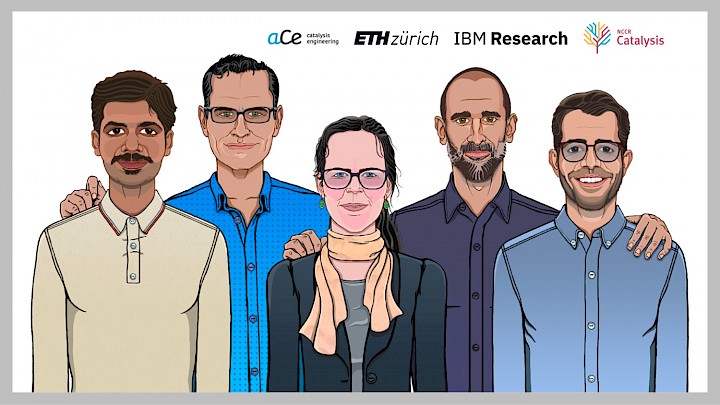
Accelerating synthesis planning for heterogeneous catalysis
Team portrait, from left to right: Manu Suvarna, Prof. Javier Pérez-Ramírez, Dr. Sharon Mitchell, Dr. Teodoro Laino, Dr. Alain Claude Vaucher. © Javier Pérez-Ramírez
In a recent collaborative publication, a team of experimental and computational experts from two NCCR Catalysis member groups have explored language models and protocol standardization guidelines to speed up synthesis planning for heterogeneous catalysts. Learn more about the work from Manu Suvarna, Dr. Sharon Mitchell and Prof. Javier Pérez-Ramírez (aCe lab, ETHZ) and Dr. Alain Vaucher and Dr. Teodoro Laino (IBM Research Zurich)!
Can you briefly introduce the concept of the project and your role?
Manu: Our project aimed at developing an automated pipeline via machine learning (ML) for the extraction of experimental synthesis procedures of single atom heterogeneous catalysts (SACs) from published literature. We used the compiled data to statistically analyze trends in SAC synthesis procedure. Eventually, based on the learning experience through the project, we identified current limitations in the way SAC-based synthesis procedures are reported, and provided guidelines to write them effectively in machine readable formats. As a PhD researcher, I wore various hats during the project, but my most important role was to translate a catalysis-oriented task into an ML problem, and serve as a bridge for exchange of insights and inferences between the two communities.
How did the collaboration between ML experts and experimental researchers come about?
Teo: The collaboration between ML experts and experimental researchers was a seamless interaction of individuals fluent in different languages - algorithms and empirical experimentation. This partnership thrived on a constant feedback loop, where ML insights informed experimental design and vice versa, elevating the quality of our research. Manu played a pivotal role by fostering curiosity and openness to learning from the ML perspective, creating an environment where diverse viewpoints flourished. This collaboration exemplifies the power of NCCR Catalysis and consequently of interdisciplinary teamwork in driving innovative breakthroughs at the intersection of technology and empirical research.
How did your experience working with experimental researchers help advance your text mining model?
Alain: The model's success was determined by its usefulness for the experimental researchers, not merely by its numerical performance. As such, we focused on tweaking the model to effectively extract what is relevant in SAC syntheses. With Manu's valuable insights, we identified and iteratively refined the model's weaknesses, ensuring it evolved to meet the precise needs of experimental researchers in this domain.
Were there any unexpected challenges that arose during the collaboration, and how did you address them?
Manu: From a technical point of view, the biggest challenge we faced was the impact of lack of data standards on model performance. Based on our experience through this project, we believe that current catalysis and chemistry literature may not be sufficiently ready to capitalize on all the benefits of language models and ML tools. In our study, we address these limitations by recommending guidelines for protocol standardization to improve machine readability. As Teo mentioned earlier, this was made possible by working in an environment where we seamlessly exchanged knowledge and shared our learning curves, to come up with an innovative solution by leveraging our respective expertise in experimental catalysis and ML.
What message or insight do you hope readers take away from your collaborative work?
Sharon: A significant takeaway is the need for experimentalists to reconsider traditional approaches in reporting synthetic protocols. In light of the crucial aspect of reproducibility of experimental results, embracing machine readable formats, like tables submitted as data files alongside articles, could greatly facilitate the integration of ML approaches to accelerate research.
Where do you see the intersection of ML and experimental research heading in the field of heterogeneous catalysis?
Teo & Manu: ML algorithms are increasingly being employed to predict catalytic properties, optimize catalyst designs, and accelerate the discovery of novel materials. The intersection of the two fields will lead to the creation of better datasets, predictive models, which will help researchers identify promising catalysts, reducing time and costs involved in experimentation. However, the field is still in its infancy and there is significant potential for the greater adoption of data-driven workflows in routine experimental works with enormous implications for chemical industry and the environment.
What role has NCCR Catalysis played in developing this work?
Javier: When we conceived NCCR Catalysis at the end of the last decade, we dreamed of studies like this one, at the interface of experimental and digital catalysis. With a cutting-edge program embracing experts in different domains, the dream has become a reality.
Publication details:
Language models and protocol standardization guidelines for accelerating synthesis planning in heterogeneous catalysis. M. Suvarna, A.C. Vaucher, S. Mitchell, T. Laino, J. Pérez-Ramírez. Nat. Commun. 2023, 14, 7964. DOI: 10.1038/s41467-023-43836-5.
In a recent collaborative publication, a team of experimental and computational experts from two NCCR Catalysis member groups have explored language models and protocol standardization guidelines to speed up synthesis planning for heterogeneous catalysts. Learn more about the work from Manu Suvarna, Dr. Sharon Mitchell and Prof. Javier Pérez-Ramírez (aCe lab, ETHZ) and Dr. Alain Vaucher and Dr. Teodoro Laino (IBM Research Zurich)!
Can you briefly introduce the concept of the project and your role?
Manu: Our project aimed at developing an automated pipeline via machine learning (ML) for the extraction of experimental synthesis procedures of single atom heterogeneous catalysts (SACs) from published literature. We used the compiled data to statistically analyze trends in SAC synthesis procedure. Eventually, based on the learning experience through the project, we identified current limitations in the way SAC-based synthesis procedures are reported, and provided guidelines to write them effectively in machine readable formats. As a PhD researcher, I wore various hats during the project, but my most important role was to translate a catalysis-oriented task into an ML problem, and serve as a bridge for exchange of insights and inferences between the two communities.
How did the collaboration between ML experts and experimental researchers come about?
Teo: The collaboration between ML experts and experimental researchers was a seamless interaction of individuals fluent in different languages - algorithms and empirical experimentation. This partnership thrived on a constant feedback loop, where ML insights informed experimental design and vice versa, elevating the quality of our research. Manu played a pivotal role by fostering curiosity and openness to learning from the ML perspective, creating an environment where diverse viewpoints flourished. This collaboration exemplifies the power of NCCR Catalysis and consequently of interdisciplinary teamwork in driving innovative breakthroughs at the intersection of technology and empirical research.
How did your experience working with experimental researchers help advance your text mining model?
Alain: The model's success was determined by its usefulness for the experimental researchers, not merely by its numerical performance. As such, we focused on tweaking the model to effectively extract what is relevant in SAC syntheses. With Manu's valuable insights, we identified and iteratively refined the model's weaknesses, ensuring it evolved to meet the precise needs of experimental researchers in this domain.
Were there any unexpected challenges that arose during the collaboration, and how did you address them?
Manu: From a technical point of view, the biggest challenge we faced was the impact of lack of data standards on model performance. Based on our experience through this project, we believe that current catalysis and chemistry literature may not be sufficiently ready to capitalize on all the benefits of language models and ML tools. In our study, we address these limitations by recommending guidelines for protocol standardization to improve machine readability. As Teo mentioned earlier, this was made possible by working in an environment where we seamlessly exchanged knowledge and shared our learning curves, to come up with an innovative solution by leveraging our respective expertise in experimental catalysis and ML.
What message or insight do you hope readers take away from your collaborative work?
Sharon: A significant takeaway is the need for experimentalists to reconsider traditional approaches in reporting synthetic protocols. In light of the crucial aspect of reproducibility of experimental results, embracing machine readable formats, like tables submitted as data files alongside articles, could greatly facilitate the integration of ML approaches to accelerate research.
Where do you see the intersection of ML and experimental research heading in the field of heterogeneous catalysis?
Teo & Manu: ML algorithms are increasingly being employed to predict catalytic properties, optimize catalyst designs, and accelerate the discovery of novel materials. The intersection of the two fields will lead to the creation of better datasets, predictive models, which will help researchers identify promising catalysts, reducing time and costs involved in experimentation. However, the field is still in its infancy and there is significant potential for the greater adoption of data-driven workflows in routine experimental works with enormous implications for chemical industry and the environment.
What role has NCCR Catalysis played in developing this work?
Javier: When we conceived NCCR Catalysis at the end of the last decade, we dreamed of studies like this one, at the interface of experimental and digital catalysis. With a cutting-edge program embracing experts in different domains, the dream has become a reality.
Publication details:
Language models and protocol standardization guidelines for accelerating synthesis planning in heterogeneous catalysis. M. Suvarna, A.C. Vaucher, S. Mitchell, T. Laino, J. Pérez-Ramírez. Nat. Commun. 2023, 14, 7964. DOI: 10.1038/s41467-023-43836-5.
20.10.2023
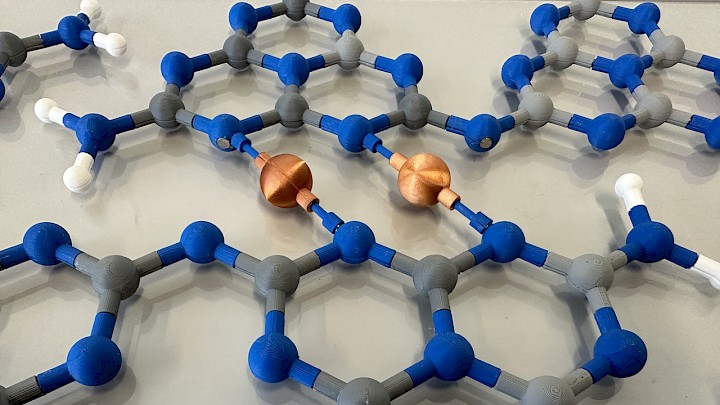
Geminal atom catalysts for more sustainable organic synthesis
In an international collaboration, researchers from the NUS, A*STAR, Tsinghua University, and ETH Zurich have explored the potential of heterogeneous geminal atom catalysts for complex molecular transformations and their environmental advantages over conventional homogeneous catalysts. In this video, NCCR Catalysis members Prof. Javier Pérez-Ramírez, Dr. Sharon Mitchell, and Prof. Gonzalo Guillén-Gosálbez from ETH Zurich share their insights about this cutting-edge research!
22.8.2023

Recipients of 2023 Turbo Grants
We are thrilled to announce the recipients of our first edition of the NCCR Catalysis Turbo Grants! This entrepreneurship program supports early-stage spin-offs in the area of sustainable chemistry and catalysis. All spin-offs are rooted in NCCR Catalysis labs, and this grant enables the researchers to dedicate their time to transitioning their research into a start-up.
We were impressed by the quality of the applications, and are glad to announce the three teams who received a 2023 Turbo Grant:
Jan Weinreich from the group of Clémence Corminboeuf at EPFL is working in the area of digital chemistry.
Benedikt Winter and Johannes Schilling from the Group of André Bardow at ETH are working in the area of digital chemistry. Since being selected, they have onboarded a third co-founder, Carl Hemprich.
Tobias Vornholt from the Thomas Ward group at UniBasel is working in the area of biocatalysis.
Congratulations to the recipients, and we're thrilled to support you as you work on your spin-offs!
We were impressed by the quality of the applications, and are glad to announce the three teams who received a 2023 Turbo Grant:
Jan Weinreich from the group of Clémence Corminboeuf at EPFL is working in the area of digital chemistry.
Benedikt Winter and Johannes Schilling from the Group of André Bardow at ETH are working in the area of digital chemistry. Since being selected, they have onboarded a third co-founder, Carl Hemprich.
Tobias Vornholt from the Thomas Ward group at UniBasel is working in the area of biocatalysis.
Congratulations to the recipients, and we're thrilled to support you as you work on your spin-offs!
27.3.2023
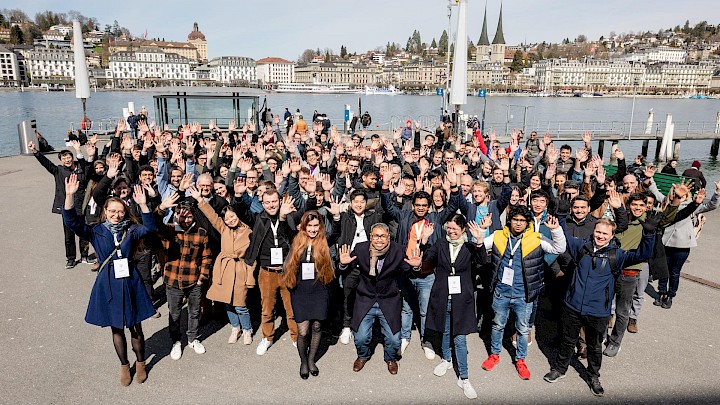
NCCR Catalysis Annual Retreat 2023
On March 27-29 2023, NCCR Catalysis held its Annual Retreat in Lucerne, Switzerland. We welcomed 150 members of our network and spent three exciting days filled with sustainable chemistry research presented by our talents, brainstorming on program activities and exchanges. It was wonderful to have our second network-wide meeting, and to connect in person!
We heard excellent presentations by the 2022 Young Talents Fellowship recipients, and talks and posters by PhD students and researchers across all five WPs. We're excited to announce the following awards:
Best Talks: Andrea Ruiz, Lopez group, ICIQ and Kevin Rossi, Pérez-Ramírez group, ETH Zurich; Ludovic Zaza, Buonsanti group, EPFL and Bojana Ranković, Schwaller group, EPFL
Best Poster: Maxime Hedou, Marti group, HES-SO
Best Poster Runner-Ups: Nieves Ramirez, Waser group, EPFL; Sebastiano D’Angelo, Guillén-Gosálbez group, ETH Zurich; and Stephan Pollitt, Nachtegaal/Safonova group, PSI
Congratulations to all awardees and many thanks to all participants for making this a fantastic community-wide event!
We heard excellent presentations by the 2022 Young Talents Fellowship recipients, and talks and posters by PhD students and researchers across all five WPs. We're excited to announce the following awards:
Best Talks: Andrea Ruiz, Lopez group, ICIQ and Kevin Rossi, Pérez-Ramírez group, ETH Zurich; Ludovic Zaza, Buonsanti group, EPFL and Bojana Ranković, Schwaller group, EPFL
Best Poster: Maxime Hedou, Marti group, HES-SO
Best Poster Runner-Ups: Nieves Ramirez, Waser group, EPFL; Sebastiano D’Angelo, Guillén-Gosálbez group, ETH Zurich; and Stephan Pollitt, Nachtegaal/Safonova group, PSI
Congratulations to all awardees and many thanks to all participants for making this a fantastic community-wide event!
27.2.2023
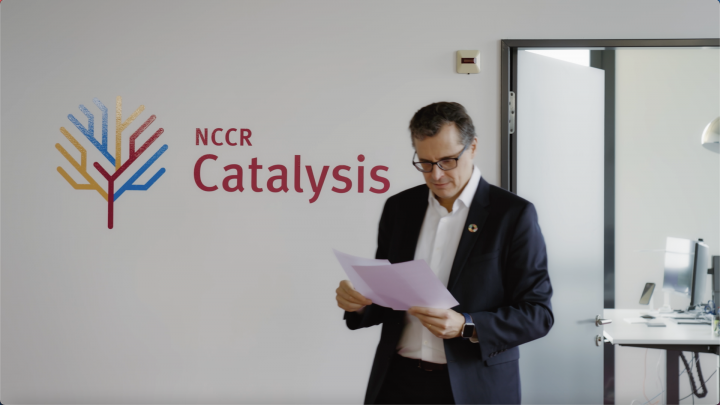
Release of statement by Director Prof. Javier Pérez-Ramírez
We are excited to release a statement by NCCR Catalysis Director Prof. Javier Pérez-Ramírez from the Department of Chemistry and Applied Biosciences at ETH Zurich. He explains why we need to switch to sustainable chemicals production urgently, addresses our program's role in this endeavor, and how we integrate sustainability into our approach. Learn more in the video!
8.2.2023
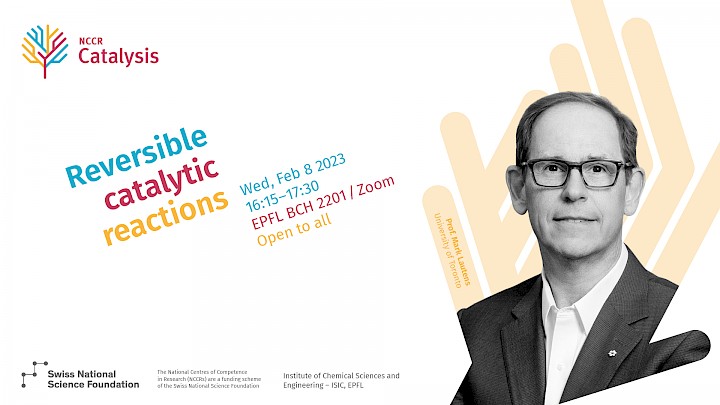
Seminar with Prof. Mark Lautens on Reversible catalytic reactions
The group of Prof. Jérôme Waser at EPFL hosted Prof. Mark Lautens as visiting professor in early 2023, where he gave a seminar on Reversible catalytic reactions.
Prof. Mark Lautens has been the J. Bryan Jones Distinguished Professor at the University of Toronto since 2013 and AstraZeneca Professor of Organic Synthesis since 1998. His group's research focuses on asymmetric catalysis with focus on rhodium, nickel and palladium catalysts, and heterocycle synthesis using metal catalysts.
Prof. Mark Lautens has been the J. Bryan Jones Distinguished Professor at the University of Toronto since 2013 and AstraZeneca Professor of Organic Synthesis since 1998. His group's research focuses on asymmetric catalysis with focus on rhodium, nickel and palladium catalysts, and heterocycle synthesis using metal catalysts.
9.1.2023

Kjell Jorner starts as Assistant Professor of Digital Chemistry
Prof. Kjell Jorner was appointed in May 2022 as Assistant Professor of Digital Chemistry at ETH Zurich’s Department of Chemistry and Applied Biosciences. He fills one of the three Assistant Professorship positions at ETH Zurich and EPFL embedded in NCCR Catalysis. We’re pleased to finally welcome you to our network and we wish you a great start, Kjell!
22.11.2022

Lecture by Prof. Heather J. Kulik on ML-accelerated computational materials discovery
We have the pleasure of welcoming Prof. Heather J. Kulik for an open-to-all lecture on Addressing challenges of data scarcity and quality in ML-accelerated computational materials discovery, co-organized with the Laboratory of Inorganic Chemistry (LAC) at ETH Zurich.
Prof. Heather J. Kulik is an Associate Professor in Chemical Engineering at MIT. Her research group focuses on computational chemistry, chemical engineering, and materials science for a wide range of applications from fundamental biochemistry to data-driven discovery of new molecules and materials.
Prof. Heather J. Kulik is an Associate Professor in Chemical Engineering at MIT. Her research group focuses on computational chemistry, chemical engineering, and materials science for a wide range of applications from fundamental biochemistry to data-driven discovery of new molecules and materials.
27.6.2022
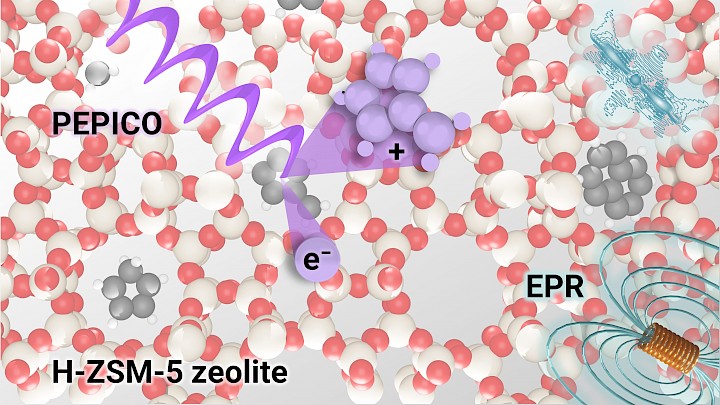
Reaction insights help make sustainable liquid fuels
Methanol, produced from carbon dioxide in the air, can be used to make carbon neutral fuels. But to do this, the mechanism by which methanol is turned into liquid hydrocarbons must be better understood so that the catalytic process can be optimised. Now, using sophisticated analytical techniques, researchers from ETH Zurich and Paul Scherrer Institute have gained unprecedented insight into this complex mechanism.
As we struggle to juggle the impact of emissions with our desire to maintain our energy hungry lifestyle, using carbon dioxide in the atmosphere to create new fuels is an exciting, carbon neutral alternative. One way to do this is to create methanol from carbon dioxide in the air, using a process called hydrogenation. This methanol can then be converted into hydrocarbons. Although these are then burnt, releasing carbon dioxide, this is balanced by carbon dioxide captured to make the fuel.
To fully develop this sustainable fuel, a deeper understanding of the mechanism by which methanol - in a reaction catalysed by zeolites, solid materials with unique porous architectures - is turned into long chain hydrocarbons, is necessary. With this in mind, in the frame of NCCR Catalysis, a Swiss National Center of Competence in Research, researchers from ETH Zurich joined forces with researchers from the Paul Scherrer Institut, PSI to reveal the details of this reaction mechanism, the findings of which are published in the journal Nature Catalysis.
“Information is key to developing more selective and stable catalysts,” explains Javier Pérez-Ramírez, Professor of Catalysis Engineering at ETH Zurich and director of NCCR Catalysis, who co-led the study. “Prior to our study, despite many efforts, key mechanistic aspects of the complex transformation of methanol into hydrocarbons were not well understood”.
The researchers were interested in comparing the methanol to hydrocarbon process with another process: that of turning methyl chloride into hydrocarbons. Oil refineries frequently burn large quantities of unwanted methane rich natural gas. This polluting and wasteful activity results in the typical flares associated with oil refineries. “Turning methyl chloride into hydrocarbons is a kind of bridge technology,” explains Pérez-Ramírez. “Of course, we would like to move away from fossil fuels but in the meantime this would be a way to avoid wasting the vast reserves of valuable methane”.Fleeting gas phase molecules tell the story
Key to understanding complex reaction mechanisms such as these is to detect the different species involved, including the intermediate products. Traditional techniques look directly at the surface of the catalyst to understand the reaction, but an important part of the story is told by gas phase molecules, which come off the catalyst.
“These molecules are often highly reactive and very short lived, decomposing within a few milliseconds. This makes identifying them a real challenge, as traditional gas phase analytical methods are simply too slow,” explains Patrick Hemberger, scientist at the vacuum ultra violet (VUV) beamline of the Swiss Light Source SLS, whose sophisticated analytical techniques would enable the researchers to study the reaction as it happened.
At the VUV beamline, Photoion Photoelectron Coincidence (PEPICO) spectroscopy has recently been established as a powerful analytical tool in catalytic reactions. It combines two different analytical techniques, photoelectron spectroscopy and mass spectrometry, to give detailed information on the gas phase reaction intermediates, even enabling differentiation between isomers.
“Because we simultaneously gather two different types of information, we can rapidly identify these fleeting species even in a mixture containing up to one hundred reaction intermediates and products. This gives us an unprecedented insight that simply isn’t possible with conventional methods,” Hemberger says.
Researchers (from left to right) Javier Pérez-Ramírez, András Bödi and Patrick Hemberger at the Swiss Light Source SLS (Photo: Paul Scherrer Institute / Markus Fischer).Reaction pathways revealed
The spectroscopy enabled the researchers to reveal how the carbon-carbon bonds form and the hydrocarbon chain grows by detecting numerous intermediate products. For the two processes – methanol to hydrocarbon and methyl chloride to hydrocarbon – the researchers observed that different reaction intermediates were occurring. From this, they could identify two distinct reaction pathways, one driven by methyl radicals, present in both reactions, and another driven by oxygenated species, so-called ketenes, which occurred only in the methanol to hydrocarbon reaction.
The researchers were also able to understand an interesting feature of the reactions: after several days, the catalyst was deactivated and the reaction stopped. This was because of the build-up of an unwanted by-product – coke, which is made from large aromatic hydrocarbons deposited during the reaction.
With the help of another spectroscopic technique, electron paramagnetic resonance spectroscopy, the researchers saw that the methyl chloride to hydrocarbon production was much more prone to coke formation than production from methanol. Armed with knowledge of the reaction pathways, the reason for this difference was clear: “The methanol to hydrocarbon route proceeds along two reaction pathways, whilst the methyl chloride to hydrocarbon route can only take the more reactive methyl radical route, which is more prone to forming coke,” explains Gunnar Jeschke, whose team at ETH Zurich performed the electron paramagnetic resonance spectroscopy studies.
Understanding the mechanism to optimise the process
The insight gained by this study is essential for the future development of liquid fuels in a sustainable manner. This could include finding ways to enhance the oxygen driven pathway, thus suppressing the formation of coke.
“We now have a deeper understanding of the reaction mechanism of methanol to hydrocarbons or methyl chloride to hydrocarbons and with this knowledge we can optimise the industrial process in a targeted way to make it more efficient,” adds Hemberger.Text and photo credit:
Paul Scherrer Institute / Miriam ArrellPublication details:Elucidation of radical- and oxygenate-driven paths in zeolite-catalysed conversion of methanol and methyl chloride to hydrocarbonsA. Cesarini, S. Mitchell, G. Zichittella, M. Agrachev, S.P. Schmid, G. Jeschke, Z. Pan, A. Bodi, P. Hemberger, J. Pérez-RamírezNat. Catal. 2022, in press (doi:10.1038/s41929-022-00808-0)
As we struggle to juggle the impact of emissions with our desire to maintain our energy hungry lifestyle, using carbon dioxide in the atmosphere to create new fuels is an exciting, carbon neutral alternative. One way to do this is to create methanol from carbon dioxide in the air, using a process called hydrogenation. This methanol can then be converted into hydrocarbons. Although these are then burnt, releasing carbon dioxide, this is balanced by carbon dioxide captured to make the fuel.
To fully develop this sustainable fuel, a deeper understanding of the mechanism by which methanol - in a reaction catalysed by zeolites, solid materials with unique porous architectures - is turned into long chain hydrocarbons, is necessary. With this in mind, in the frame of NCCR Catalysis, a Swiss National Center of Competence in Research, researchers from ETH Zurich joined forces with researchers from the Paul Scherrer Institut, PSI to reveal the details of this reaction mechanism, the findings of which are published in the journal Nature Catalysis.
“Information is key to developing more selective and stable catalysts,” explains Javier Pérez-Ramírez, Professor of Catalysis Engineering at ETH Zurich and director of NCCR Catalysis, who co-led the study. “Prior to our study, despite many efforts, key mechanistic aspects of the complex transformation of methanol into hydrocarbons were not well understood”.
The researchers were interested in comparing the methanol to hydrocarbon process with another process: that of turning methyl chloride into hydrocarbons. Oil refineries frequently burn large quantities of unwanted methane rich natural gas. This polluting and wasteful activity results in the typical flares associated with oil refineries. “Turning methyl chloride into hydrocarbons is a kind of bridge technology,” explains Pérez-Ramírez. “Of course, we would like to move away from fossil fuels but in the meantime this would be a way to avoid wasting the vast reserves of valuable methane”.Fleeting gas phase molecules tell the story
Key to understanding complex reaction mechanisms such as these is to detect the different species involved, including the intermediate products. Traditional techniques look directly at the surface of the catalyst to understand the reaction, but an important part of the story is told by gas phase molecules, which come off the catalyst.
“These molecules are often highly reactive and very short lived, decomposing within a few milliseconds. This makes identifying them a real challenge, as traditional gas phase analytical methods are simply too slow,” explains Patrick Hemberger, scientist at the vacuum ultra violet (VUV) beamline of the Swiss Light Source SLS, whose sophisticated analytical techniques would enable the researchers to study the reaction as it happened.
At the VUV beamline, Photoion Photoelectron Coincidence (PEPICO) spectroscopy has recently been established as a powerful analytical tool in catalytic reactions. It combines two different analytical techniques, photoelectron spectroscopy and mass spectrometry, to give detailed information on the gas phase reaction intermediates, even enabling differentiation between isomers.
“Because we simultaneously gather two different types of information, we can rapidly identify these fleeting species even in a mixture containing up to one hundred reaction intermediates and products. This gives us an unprecedented insight that simply isn’t possible with conventional methods,” Hemberger says.
Researchers (from left to right) Javier Pérez-Ramírez, András Bödi and Patrick Hemberger at the Swiss Light Source SLS (Photo: Paul Scherrer Institute / Markus Fischer).Reaction pathways revealed
The spectroscopy enabled the researchers to reveal how the carbon-carbon bonds form and the hydrocarbon chain grows by detecting numerous intermediate products. For the two processes – methanol to hydrocarbon and methyl chloride to hydrocarbon – the researchers observed that different reaction intermediates were occurring. From this, they could identify two distinct reaction pathways, one driven by methyl radicals, present in both reactions, and another driven by oxygenated species, so-called ketenes, which occurred only in the methanol to hydrocarbon reaction.
The researchers were also able to understand an interesting feature of the reactions: after several days, the catalyst was deactivated and the reaction stopped. This was because of the build-up of an unwanted by-product – coke, which is made from large aromatic hydrocarbons deposited during the reaction.
With the help of another spectroscopic technique, electron paramagnetic resonance spectroscopy, the researchers saw that the methyl chloride to hydrocarbon production was much more prone to coke formation than production from methanol. Armed with knowledge of the reaction pathways, the reason for this difference was clear: “The methanol to hydrocarbon route proceeds along two reaction pathways, whilst the methyl chloride to hydrocarbon route can only take the more reactive methyl radical route, which is more prone to forming coke,” explains Gunnar Jeschke, whose team at ETH Zurich performed the electron paramagnetic resonance spectroscopy studies.
Understanding the mechanism to optimise the process
The insight gained by this study is essential for the future development of liquid fuels in a sustainable manner. This could include finding ways to enhance the oxygen driven pathway, thus suppressing the formation of coke.
“We now have a deeper understanding of the reaction mechanism of methanol to hydrocarbons or methyl chloride to hydrocarbons and with this knowledge we can optimise the industrial process in a targeted way to make it more efficient,” adds Hemberger.Text and photo credit:
Paul Scherrer Institute / Miriam ArrellPublication details:Elucidation of radical- and oxygenate-driven paths in zeolite-catalysed conversion of methanol and methyl chloride to hydrocarbonsA. Cesarini, S. Mitchell, G. Zichittella, M. Agrachev, S.P. Schmid, G. Jeschke, Z. Pan, A. Bodi, P. Hemberger, J. Pérez-RamírezNat. Catal. 2022, in press (doi:10.1038/s41929-022-00808-0)
20.6.2022
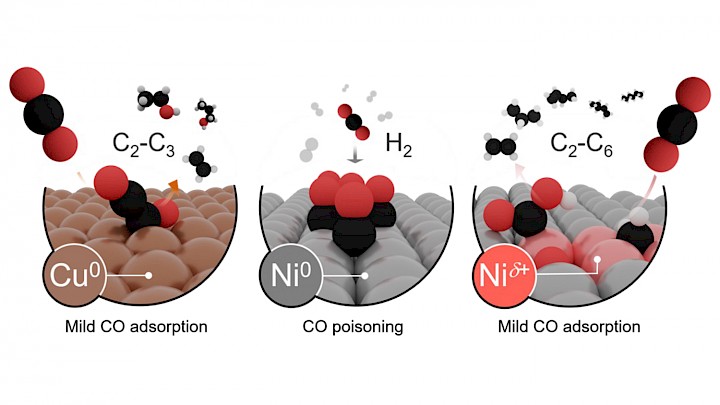
Nickel electrocatalysts for one-step synthesis of long hydrocarbons from CO2
A collaboration supported by NCCR Catalysis between the groups of Profs. J. Pérez-Ramírez at ETH Zurich, B.S. Yeo at the National University of Singapore (NUS), and N. López at the Institute of Chemical Research of Catalonia (ICIQ) has led to the discovery of a new family of materials able to transform electrocatalytically carbon dioxide into long hydrocarbons at room temperature and pressure. After four decades of intense research efforts, no more than three carbon dioxide molecules could be coupled in a single step at appreciable rates over electrocatalysts based exclusively on copper. The products obtained were ethylene, ethanol and propanol. In contrast, the new family of nickel-based catalysts can couple up to six CO2, giving direct access now to a richer pool of products, with selectivities to linear and branched hydrocarbons of 16% and up to 7% to C3-C6 products. These breakthrough results have been recently published in Nature Catalysis.
The formation of long carbon products was detected during a search for alternative catalysts to copper. Metallic nickel is typically a poor CO2 reduction catalyst because it adsorbs carbon monoxide, a key intermediate in the reaction, too strongly, stopping the reaction. However, using inorganic nickel oxygenates such as nickel phosphate or carbonate, the team could identify up to 28 different products. Extensive experimental and computational efforts managed to identify the key to the unique performance: the ability to keep a few nickel-oxygen bonds in the electrode during the reaction. This generates polarized nickel atoms (Nid+) that only weakly adsorb carbon monoxide, enabling the coupling of carbon species. These results encourage further research towards the implementation of Ni-based technologies in the future. The team is already working to exploit the new research avenue these catalysts open, as they think we may have only scratched their potential. More information available in https://doi.org/10.1038/s41929-022-00803-5.Image credit:
Javier Pérez-RamírezPublication details:Long-chain hydrocarbons via CO2 electroreduction enabled by polarized nickel catalysts
Y. Zhou, A.J. Martín, F. Dattila, S. Xi, N. López, J. Pérez-Ramírez, B.S. YeoNat. Catal. 2022, in press (doi:10.1038/s41929-022-00803-5)
The formation of long carbon products was detected during a search for alternative catalysts to copper. Metallic nickel is typically a poor CO2 reduction catalyst because it adsorbs carbon monoxide, a key intermediate in the reaction, too strongly, stopping the reaction. However, using inorganic nickel oxygenates such as nickel phosphate or carbonate, the team could identify up to 28 different products. Extensive experimental and computational efforts managed to identify the key to the unique performance: the ability to keep a few nickel-oxygen bonds in the electrode during the reaction. This generates polarized nickel atoms (Nid+) that only weakly adsorb carbon monoxide, enabling the coupling of carbon species. These results encourage further research towards the implementation of Ni-based technologies in the future. The team is already working to exploit the new research avenue these catalysts open, as they think we may have only scratched their potential. More information available in https://doi.org/10.1038/s41929-022-00803-5.Image credit:
Javier Pérez-RamírezPublication details:Long-chain hydrocarbons via CO2 electroreduction enabled by polarized nickel catalysts
Y. Zhou, A.J. Martín, F. Dattila, S. Xi, N. López, J. Pérez-Ramírez, B.S. YeoNat. Catal. 2022, in press (doi:10.1038/s41929-022-00803-5)
10.6.2022
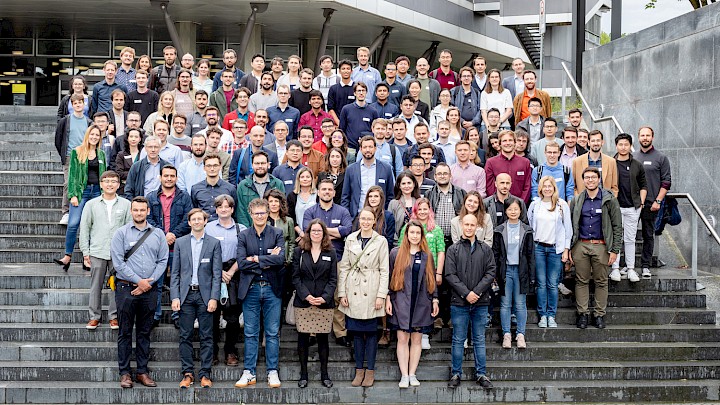
NCCR Catalysis Annual Event 2022
On June 9-10 2022, NCCR Catalysis held its first Annual Event at ETH Zurich, Campus Hönggerberg. We welcomed 145 members of our network and spent two exciting days filled with catalysis and sustainable chemistry research presented by our talents. It was a wonderful to have our first physical meeting after 22 months of operation, and to connect in person!
We saw excellent presentations and posters by PhD students and researchers across all five WPs and are excited to announce the following awards:
Best Talk: Anastasiia Komarova, Luterbacher group, EPFL
Runner Up Talks: Thomas Moragues, deMello group, ETH Zurich and Mojmir Mutny, Krause group, ETH Zurich
Best Poster: Alessandra Toniato, Laino group, IBM Research Zurich
Runner Up Posters: Ludovic Zaza, Buonsanti group, EPFL and Lukas Spiekermann, Bardow group, ETH Zurich
Congratulations to all awardees and many thanks to all participants for making this a fantastic community-wide event!
We saw excellent presentations and posters by PhD students and researchers across all five WPs and are excited to announce the following awards:
Best Talk: Anastasiia Komarova, Luterbacher group, EPFL
Runner Up Talks: Thomas Moragues, deMello group, ETH Zurich and Mojmir Mutny, Krause group, ETH Zurich
Best Poster: Alessandra Toniato, Laino group, IBM Research Zurich
Runner Up Posters: Ludovic Zaza, Buonsanti group, EPFL and Lukas Spiekermann, Bardow group, ETH Zurich
Congratulations to all awardees and many thanks to all participants for making this a fantastic community-wide event!
8.6.2022
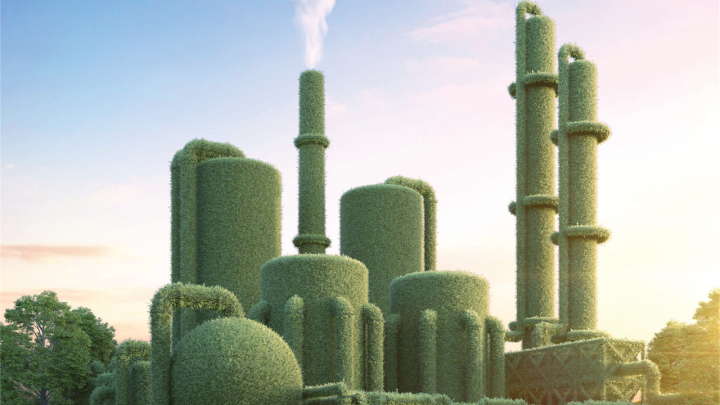
Release of video on sustainability of chemicals through the lens of planetary boundaries
We had a great time shooting a video with the teams of Prof. Javier Pérez-Ramírez and Prof. Gonzalo Guillén-Gosálbez from ETH Zurich on their NCCR Catalysis study on sustainability assessments of chemicals production, and are excited to see it released!
The teams investigated whether the production of the 492 most relevant chemicals is sustainable with respect to transgression of planetary boundaries. In this NCCR Catalysis study, they found that 99.4% of these chemicals exceed at least one such boundary, which makes them unsustainable in the long term. Learn more about their findings in the video and the publication!
The teams investigated whether the production of the 492 most relevant chemicals is sustainable with respect to transgression of planetary boundaries. In this NCCR Catalysis study, they found that 99.4% of these chemicals exceed at least one such boundary, which makes them unsustainable in the long term. Learn more about their findings in the video and the publication!
31.5.2022
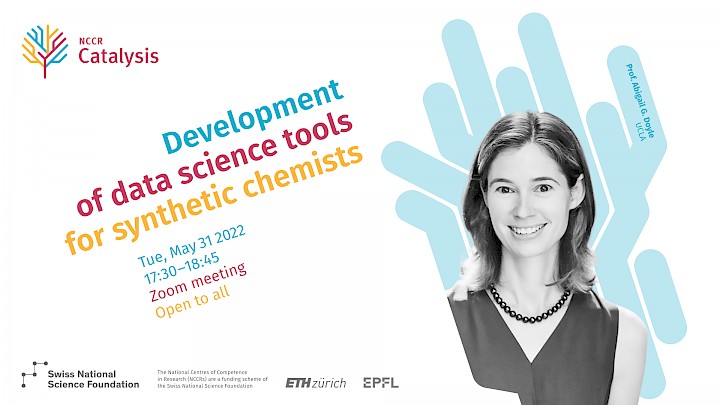
Seminar with Prof. Abigail G. Doyle on data science tools for synthetic chemists
We had the pleasure of welcoming Prof. Abigail G. Doyle for an open-to-all seminar on Development of data science tools for synthetic chemists, co-organized with Dr. Teodoro Laino.
Prof. Abigail G. Doyle is the Saul Winstein Chair in Organic Chemistry at UCLA since 2021, previously the A. Barton Hepburn Professor of Chemistry at Princeton University. Her group's research focuses on the interface of organic, organometallic, physical organic, and computational chemistry. They develop catalysts, catalytic reactions, and synthetic methods, also applying mechanistic and computer-assisted techniques to understand the principles guiding these catalytic reactions.
Prof. Abigail G. Doyle is the Saul Winstein Chair in Organic Chemistry at UCLA since 2021, previously the A. Barton Hepburn Professor of Chemistry at Princeton University. Her group's research focuses on the interface of organic, organometallic, physical organic, and computational chemistry. They develop catalysts, catalytic reactions, and synthetic methods, also applying mechanistic and computer-assisted techniques to understand the principles guiding these catalytic reactions.
12.5.2022
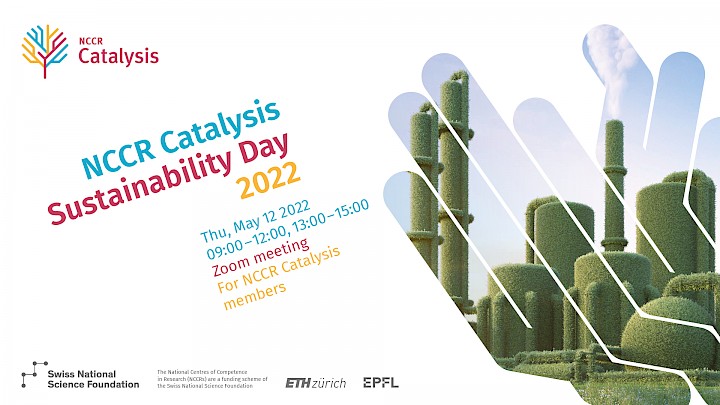
NCCR Catalysis Sustainability Day 2022
On May 12 2022, NCCR Catalysis held its first Sustainability Day. The morning session combined lectures from experts bringing industry and academic perspectives on sustainability assessment with a panel discussion.
The afternoon covered the status quo within NCCR Catalysis and provided an opportunity for brainstorming on how to address sustainability moving forward. We thank all speakers, moderators and participants for their contributions and lively discussions!
The afternoon covered the status quo within NCCR Catalysis and provided an opportunity for brainstorming on how to address sustainability moving forward. We thank all speakers, moderators and participants for their contributions and lively discussions!
19.4.2022
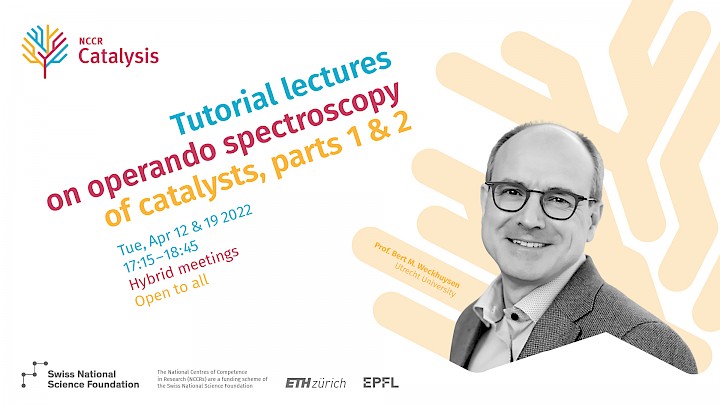
Tutorial lectures by Prof. Bert Weckhuysen on operando spectroscopy of catalysts
We had the pleasure of welcoming Prof. Bert M. Weckhuysen for two tutorial lectures held in hybrid mode. In part 1, Prof. Weckhuysen led us through the history, social network of the community, trends and practical aspects of operando spectroscopy of catalysts.
In part 2, he discussed cell design suggestions, and advances towards capturing molecular movies of real-life catalysts. We thank Prof. Weckhuysen for the insightful lectures, the group of Prof. Christophe Copéret for organizing, and all attendees for joining us! You can find the lecture recordings on our YouTube channel: part 1 and part 2.
Prof. Bert M. Weckhuysen is a full professor at Utrecht University, where his group focuses on the development of structure-activity relationships and expert systems in the field of heterogeneous catalysis and materials science. His research group places special emphasis on the development and use of advanced in situ characterization techniques. He is currently a visiting professor in Prof. Christophe Copéret’s group at the Department of Chemistry and Applied Biosciences at ETH Zurich, and member of the NCCR Catalysis International Advisory Board.
In part 2, he discussed cell design suggestions, and advances towards capturing molecular movies of real-life catalysts. We thank Prof. Weckhuysen for the insightful lectures, the group of Prof. Christophe Copéret for organizing, and all attendees for joining us! You can find the lecture recordings on our YouTube channel: part 1 and part 2.
Prof. Bert M. Weckhuysen is a full professor at Utrecht University, where his group focuses on the development of structure-activity relationships and expert systems in the field of heterogeneous catalysis and materials science. His research group places special emphasis on the development and use of advanced in situ characterization techniques. He is currently a visiting professor in Prof. Christophe Copéret’s group at the Department of Chemistry and Applied Biosciences at ETH Zurich, and member of the NCCR Catalysis International Advisory Board.
31.3.2022

Videos on life cycle assessment of chemicals
PhD student Jing Huo and postdoctoral researcher Dr. Eric Bradford, both working in the group of Prof. Stefanie Hellweg, Core PI at ETH Zurich, summarized their NCCR Catalysis projects in short videos. Their work addresses evaluation of the environmental sustainability of a broad range of chemical products and processes, including catalysts, at an early design stage.
The goal of Jing's work is to inform the chemical industry and policymakers about which strategies to pursue in transitioning to renewable feedstocks. Therefore, she aims to provide a holistic comparison of environmental benefits and trade-offs of chemicals produced from different feedstocks and pathways under different scenarios. The work focuses on CO2 and biomass as chemical feedstocks, including their future regional supply-demand balance and environmental impacts based on projected sourcing mechanisms. A case study will address the optimization potential of upstream supply chain of the chemical manufacturing sites in Europe, with the aim of minimizing total environmental impacts from feedstock sourcing, transportation, and conversion.Eric's work focuses on developing a pre-life cycle assessment (LCA) framework for evaluating new chemicals. Currently, life-cycle inventories are lacking for most chemicals, which hampers assessments of their environmental impact. While over 100 million chemicals are registered, LCAs cannot be carried out for most of them because of insufficient data. This is why model-based estimations are needed to fill data gaps during early design stages of molecule and process. Eric makes use of state-of-the-art machine learning techniques to address data deficiencies and to improve the quality of LCAs for both basic and fine chemicals of different levels of complexity in the molecular structure. The tool's aim is to complement existing public and industry LCA databases of chemicals, particularly by screening LCA results of complex chemicals that are otherwise not available, and to be used in design evaluation of chemical molecules and processes for the development of greener chemicals and processes.
Well done, Jing and Eric!
The goal of Jing's work is to inform the chemical industry and policymakers about which strategies to pursue in transitioning to renewable feedstocks. Therefore, she aims to provide a holistic comparison of environmental benefits and trade-offs of chemicals produced from different feedstocks and pathways under different scenarios. The work focuses on CO2 and biomass as chemical feedstocks, including their future regional supply-demand balance and environmental impacts based on projected sourcing mechanisms. A case study will address the optimization potential of upstream supply chain of the chemical manufacturing sites in Europe, with the aim of minimizing total environmental impacts from feedstock sourcing, transportation, and conversion.Eric's work focuses on developing a pre-life cycle assessment (LCA) framework for evaluating new chemicals. Currently, life-cycle inventories are lacking for most chemicals, which hampers assessments of their environmental impact. While over 100 million chemicals are registered, LCAs cannot be carried out for most of them because of insufficient data. This is why model-based estimations are needed to fill data gaps during early design stages of molecule and process. Eric makes use of state-of-the-art machine learning techniques to address data deficiencies and to improve the quality of LCAs for both basic and fine chemicals of different levels of complexity in the molecular structure. The tool's aim is to complement existing public and industry LCA databases of chemicals, particularly by screening LCA results of complex chemicals that are otherwise not available, and to be used in design evaluation of chemical molecules and processes for the development of greener chemicals and processes.
Well done, Jing and Eric!
8.10.2021
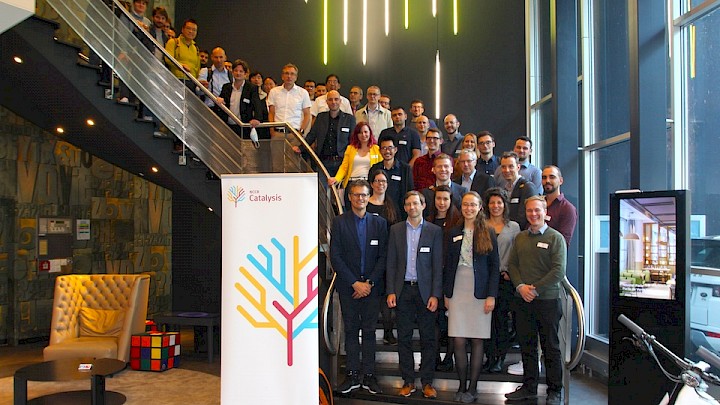
Conclusion of Y1 with evaluation meeting
Our program turned one in August 2021, and we wrapped up the first year with an in-person evaluation meeting in October, held in Bern. We warmly thank all consortium members for their efforts in summarising 77 research projects and the work of more than 200 people. We also thank our review panel, and the SNSF, ETH Zurich and EPFL representatives for the constructive discussions!